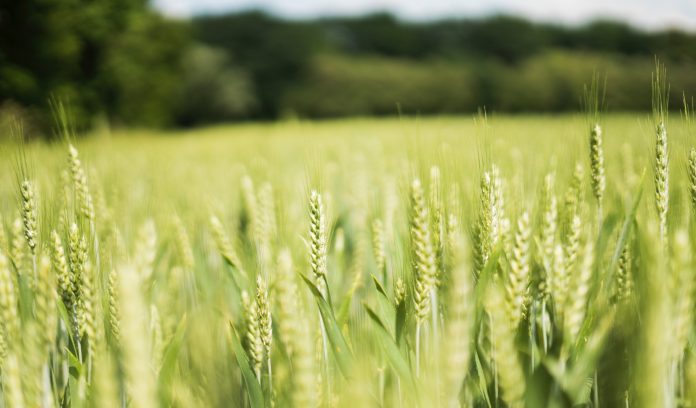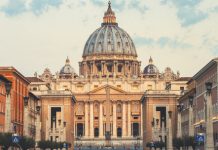
Ideas and activities for celebrating the Easter Season at home and in the classroom.
Maryann Ziemer
For suggestions about how the family can focus on the joy of Easter as they gather at the family table for mealtime, see “At the Family Table during the Easter Season” at the end of this article.
Light for the World and a Grain of Wheat
The Easter Season, when we celebrate Jesus’ Resurrection following his suffering and death. Let’s consider Jesus’ declaration that “I am the light” and, in the context of his sacrifice, his parable about a single grain of wheat.
You can help your students share the joy and meaning of the season with their families. Make copies of the following reflections, spanning seven weeks of the Easter Season, and have students take them home to share.
Week One: We Appreciate Light and Growth
Jesus’ parables and stories, told in his intimate and familiar style, are grounded in the senses. He speaks of sight, hearing, touch; of people’s need for food, water, shelter. He speaks of love. Jesus helps us feel the heat of the day and the laborers’ fatigue; we see the farmer’s ripening fields.
Time and again, the Son of God shows his own humanity through a profound understanding of human affliction and deprivation. In elegant simplicity and with words and actions meaningful to the people, Jesus reveals his absolute comprehension of human need.
In his use of light and wheat imagery, Jesus speaks of things familiar to his listeners. The farmer knows from experience that the single grain of wheat must enter the soil and die or it cannot become many grains of wheat. He knows that the sun’s light must also play a part. The sun must fall on the fields for the wheat to grow from seed to harvest.
Talk about: In his descriptions of the death, germination, and growth of a grain of wheat, and of himself as the light, Jesus uses the familiar to describe the new. He introduces the people to the concept of salvation and of his own ultimate sacrificial role in it.
Week Two: We Understand the Importance of Light
We absolutely need light. We cannot function completely in the dark. We cannot live nor thrive without light.
Light is a form of energy, originating in the seething activity of the sun. The light of the sun travels through cold, dark space, reaching the earth in various energy levels, from gamma rays to visible light rays to infrared.
Human beings have discovered many ways to use the various energy levels of light. X-rays reveal our bones for medical purposes. Microwave energy cooks food quickly for our convenience. Radio waves help us communicate across long distances. And it is through the energy of visible light waves that Easter lilies grow and wheat crops flourish.
Talk about: Visible light waves make possible our gift of sight. Without light, we cannot see. Close your eyes and all is dark. Injure or destroy the eye’s ability to receive and process light energy, and the sense of sight is gone. It is through light—reflected from objects and entering our eyes through a wondrous, instantaneous, God-given process of biochemical and bioelectrical signals—that we see objects, the colors of the universe, the world around us.
Week Three: We Stand in the Light of Jesus
Jesus says to the people, “I am the light.” Now the people of the time knew the importance of light. It was during the hours of daylight that they could tend their fields and vineyards, herd their sheep, and manage their daily chores. Their light sources—lamps and burning oils—were valued possessions, tended to carefully. In fact, the lighting of lamps each evening was a blessing ritual. In declaring himself “the light,” Jesus places himself within the people’s everyday experience—familiar and essential to life itself.
When we hear Jesus make that most fundamental declaration—“I am the light”—we sense the enormity of it all. For if Jesus is light, then he is also the energy of light, transmitted to us through his teaching, loving sacrifice, and Resurrection—by which our salvation is secured.
Talk about: As Jesus’ disciples, we stand in his light. The light of Jesus enters our lives so we see, understand, and know with the eyes of faith. We see the goodness of a loving, compassionate, and generous God. We understand that we are invited, through Jesus, to know God. And, in turn, we reflect Jesus’ light to others.
Week Four: We Reflect the Light of Jesus
Our Catholic faith tradition and Judaic heritage are rich in the imagery of light. God provided a column of fire to give the Israelites light through the night in their journey out of Egypt (Exodus 13:21). Isaiah calls the house of Jacob to walk in the light of the Lord (Isaiah 2:5). The psalmist praises God as light and salvation, and so knows no fear (Psalm 27:1).
Paul is struck by a blinding light and is changed forever (Acts 9:1-30). The widow lights a lamp to look for a lost coin (Luke 15:8-10). In Matthew 5:15, Jesus speaks of the light that is not put under a basket but, instead, is placed on a stand to give light to the whole house—and in the same way, we let our light shine for the glory of God. The Gospel of John proclaims Jesus as the light that enlightens everyone (John 1:9). And Jesus restores the sight of the blind man whose eyes can then process the energy of light (John 9).
Talk about: We reflect Jesus’ light by following his teaching and imitating his example in our lives of service, sacrifice, and love. We direct the energy of Jesus’ light of love to good purpose.
Week Five: We Pray and Celebrate with Light
In our worship spaces and in our rituals, we use light to dispel darkness and add beauty to our liturgical expressions. Who has experienced the gradual extinguishing of candles during a Holy Week Tenebrae service and come away unmoved by the dramatic play of light and dark?
The Easter Vigil brings the blessing of fire that symbolizes the dispelling of the darkness of sin and death. The light of the paschal candle, touching its flame to the wicks of many smaller candles, symbolizes Christ spreading his light to all. Easter is the feast of light overcoming darkness.
Talk about: Light brings joyfulness, festivity, a sense of knowing. Think about how often we use light in celebration, commemoration, and discovery. Candles grace birthday cakes and holiday tables. Searchlights sweep the night sky to announce a new business opening. Fireworks celebrate the birth of a nation. Multi-colored lights celebrate the birth of our Savior. Two columns of steady upward light mark the site of fallen towers. Telescopes and microscopes focus light to reveal wondrous worlds, large and small. And it is by light’s energy that plants grow and crops flourish. Without light, that single grain of wheat could never grow and give rise to much fruit.
Week Six: We Produce Much Fruit
To the listening crowd of people, Jesus describes the fate of a grain of wheat: “Unless a grain of wheat falls to the ground and dies, it remains just a grain of wheat, but if it dies, it produces much fruit” (John 12:24). From a single grain will come many.
Jesus’ listeners know what he is talking about. They understand wheat. It’s fundamental to their well-being. From it is made bread, the staff of their life. So when Jesus says that a single grain of wheat must die, essentially losing its identity as a single grain—sacrificed to make many stalks of wheat possible—they know what he means. We, too, understand that a grain must germinate, push through the earth, and, under the light and warmth of the sun, grow to become the source of many new grains.
In parable style, Jesus describes his own fate, telling the crowd that he, too, will die, sacrificed like that grain of wheat. And like the grain of wheat, his death will bear much fruit; it will give rise to many.
Talk about: Who are the “many”? Jesus’ followers are the many. We are the many. We, by Jesus’ teaching and sacrifice, live in the sight and love of God.
Week Seven: We Pray and Celebrate with Wheat
From the time of the Jewish Passover meal that became Christ’s Last Supper, our rituals and prayers have been rich in references to the grain of wheat, to harvests, to bread. We express it in our communal meals, in our mission to feed the hungry, in thanksgiving for abundant crops, and in the ultimate bread of life that we share in the Eucharist.
The imagery is all around us. Sheaves of wheat and loaves of bread are artfully depicted in the stained glass and carved wood of our worship spaces. In our Scripture readings we hear of the unleavened bread of our ancestors in faith who prepared for flight (Exodus 12:8-11).We hear of the manna that God provided as food in the desert (Exodus 16:4), and we hear God promise the oppressed that they shall not want for bread (Isaiah 51:14). We marvel at the baskets of bread left over from feeding the hungry thousands (John 6:13), and we know the significance of Jesus blessing, breaking, and sharing the bread at the Last Supper (Mark 14:22). Our Easter Vigil often includes the ritual blessing of foods, wheat bread among them.
Talk about: At the core of all this is our belief in the suffering, death, and Resurrection of Jesus. Jesus—that single grain of wheat—falls, dies, and rises from death itself. Jesus is our salvation. Jesus is the eternally abundant and saving bread of life.
Activities with Light
Light travels in a straight line but it can be reflected to shine elsewhere. Its energy causes change. Here are two activities demonstrating these two properties of light: redirecting light and using the energy of light to bring about change. These activities illustrate a relationship to Jesus as the light of the world that we, his followers, reflect to others and thereby bring about change in people’s hearts.
ACTIVITY 1
You will need
* flashlight
* mirror
* darkened room
What to do
1. Shine the flashlight beam around the darkened room. Observe that light travels in a straight line, from the flashlight to wherever the flashlight is pointed: the ceiling, the wall, the floor, a student’s shirt. 2. Now shine the flashlight beam onto a mirror.
Observe: The straight line of light can be sent to different places in the room if the mirror is tilted one way or the other.
Talk about: As followers of Jesus, we receive his light and reflect it to others each time we show love and give service.
ACTIVITY 2
You will need
* sheets of black construction paper, one for each student
* small items (eraser, toy block) for each student
* a sunny day
What to do
1. Place the sheets of black paper in a sunny place and put a small item in the middle of each sheet. Be sure the sheets of paper and objects are in direct and bright sunlight.
2. After several hours, lift the items from the papers.
Observe: The color of the paper under the items is still black but the rest of the surrounding area is faded.
Talk about: The sun’s light energy has changed the color of the paper. The energy of Jesus’ light changes people’s hearts, moving them to love and serve each other.
Making the home connection: Have students take home their sun-faded papers to show to their families how the energy of light causes change. Then they can explain how the energy of Jesus’ light causes change in the human heart. Encourage them to tell their families about the flashlight activity.
Growing Wheat
Students can see how the ”death” of one grain of wheat produces abundant fruit, giving them a concrete example of Jesus’ parable about the grain of wheat falling to the ground and dying to produce much fruit.
You will need
* grains of wheat, called berries (Be sure to get natural grains that are capable of germinating. A 28-ounce bag of organic wheat berries costs about $3.00 at my local produce market. They come from Bob’s Red Mill Natural Foods, 13521 SE Pheasant Court, Milwaukie, OR 97222; 800-349-2173; bobsredmill.com. Natural food stores also carry wheat berries.)
* small clear plastic bags, one for each student
* 8-ounce plastic cups, one for each student
* potting soil
* large clay pot
* water
* a location with natural daylight
What to do
1. Place about twenty wheat berries in each plastic bag, one bag for each student. 2. Have students hold their bags up to a bright light or a sunny window to observe the darker spot at one end of each of the berries. Explain that the dark spot is the tiny plant embryo leaf and stem. The rest of the grain is food for the germinating embryo to use until it pushes through the soil into daylight. Then it can make its food from water and nutrients in the soil and carbon dioxide from the air, powered by the sun’s light energy. 2. Fill each plastic cup with soil. 3. Place half of the wheat berries in the baggies onto the soil in the cups and lightly cover the berries with more soil. 4. Water gently and lightly. (Save the remaining wheat berries in plastic bags for later.) 5. Place potting soil in the large clay pot. 6. Plant berries in the clay pot in the same way they were planted in the plastic cups. 7. Place the plastic cups and the clay pot in a sunny area. 8. Water the plants and observe them carefully each time your class meets.
Observe: Each time you meet with your students, carefully note how the plants have changed. Be sure to water the plants regularly and carefully. You may want to keep a simple record of what you and your students do and observe each week.
Talk about: Seeing the first blades begin to push through the soil is exciting. As the grassy blades grow taller, they become slender pale-green sheaths with developing grains visible within them. Point to the developing grains. Count them. All from just a few berries!
Making the home connection: Encourage students to take home their wheat plants and the plastic bags of unplanted wheat berries. Tell them to show the wheat berries to their families, explain what they learned about the plant embryo and food, and show the new wheat that is growing in their plastic cups. The family, too, will see how each single grain of wheat has become a new wheat plant that will bear many more grains of wheat—just like Jesus explains in his parables.
Note: When I did this activity, I observed 3-inch grass-like shoots 4 days after planting the wheat berries. After several more days, I could see grains forming within the grassy shafts. Several weeks later, fully formed grain heads appeared, each packed with many grains from which extended bristle-like awns in the familiar wheat pattern. The wheat eventually dried to a golden brown and I was able to “harvest” many grains. Have your students do likewise with their classroom wheat!
At the Family Table during the Easter Season
Mealtimes, when parents and children come together, can become frequent occasions to observe and expand the richness of the Easter Season in the home. Here are some suggestions that can help families focus on the joy of Easter as they gather at the family table.
1. Consider the beauty of the table.
We make our worship spaces visually beautiful and pleasing environments where we come together in community. In the same way, it’s appropriate to make the dinner table, where we come together as family, a lovely and inviting place.
Set the table with a cloth or placemats or runner, and nicely arrange the plates, silverware, glasses, and napkins at each place. The table setting doesn’t have to be elaborate. Just set the table in a way that makes it obvious that all was positioned thoughtfully and with care.
2. Place candles on the table.
Candlelight gives significance to an occasion. Even the youngest family members sense that something special is happening. Candles on the family dinner table can be a reminder to older children that Jesus described himself as the Light.
Make lighting your candles (and extinguishing them at the end of the meal) a small ritual that calls attention to the flames’ warmth and light, and how it changes the whole atmosphere of the meal and the family’s sense of participation. Think about lighting the candles during your Prayer before Meals.
3. Make a centerpiece for the table.
Flanked by soft candlelight, the simplest centerpiece arrangement gives added grace and dignity to your family table.
Centerpiece components might be something as simple as small bowls or clear glass containers filled with wheat flour or dry pasta of various shapes. Or you might spread dried wheat (available from craft stores for a few dollars) underneath a napkin-lined basket that contains dinner rolls or slices of bread.
4. Bring a small bowl of wheat flour to the table.
Invite family members to observe and touch the refined white (or whole wheat) flour. Note the difference in how it looks and feels compared to the natural, unrefined wheat berries that were brought home from school.
5. Call attention to foods made with wheat flour.
Family meals often include kid favorites such as pizza, spaghetti, macaroni and cheese, rolls, breads, muffins, cookies, and cakes. Most often, these are made with wheat flour. During meals that include such foods, talk about flour as an ingredient. Discuss how adding other ingredients and mixing, heating, cooking, or baking has changed the nature of the flour to produce something entirely different.
6. Engage the family in preparing a simple food made with wheat flour.
During the weeks before Easter, some families may have a simple soup-and-bread supper. Here is an easy and quick bread recipe that kids, with adequate adult supervision, can help make and that becomes part of such a family meal.
Plain Muffins (makes 12)
1 egg
1 cup milk
1/4 cup vegetable oil
2 cups all-purpose flour
1/4 cup sugar
2 1/2 teaspoons baking powder
1/2 teaspoon salt
large bowl and mixing spoon
measuring cup
measuring spoons
muffin tin
paper baking cups
waxed paper
Heat the oven to 400º F. Line the muffin tin with the paper baking cups. In a large bowl, beat egg lightly, add milk and oil. Blend flour, sugar, baking powder and salt on a large piece of waxed paper. Funnel the flour mixture from the waxed paper into the liquid mixture and stir until flour is just moistened. Fill muffin cups about 2/3 full. Bake 20 to 25 minutes until golden brown with rounded bumpy tops.
7. Hear the song, speak the words.
Look through any hymnal index and you will find many songs with lyrics that focus on wheat or bread or light and change. At the family table during the Easter Season, consider having soft background music that features such songs, or incorporate part of a song into the Prayer before Meals. Here are several suggestions for CDs with songs that might be appropriate:
City of God by John Michael Talbot (Song 7: “Gift of Finest Wheat”)
Table of Plenty by John Michael Talbot (Song 1: “Table of Plenty”)
Catholic Classics, Volume I (GIA Publications. Song 4: “Eat This Bread”; Song 10, “I Am the Bread of Life”)
The family might also learn a short verse or compose its own set of words that becomes part of the at-table prayer during the Easter Season. A source for ideas is Together We Pray: A Prayer Book for Families (Chalice Press), J. Bradley Wigger, “Grain” (p. 31). Based on Psalm 72:16: “May there be an abundance of grain upon the earth; on the tops of the mountains the crops shall rustle like Lebanon; the city dwellers shall flourish like the verdure of the fields.”
Maryann Ziemer is a published author with teaching experience in pre-K, kindergarten, and seventh-grade religious education. She writes about subjects related to health, science, and education.
This article was originally published in Catechist magazine, February 2010.
Photo by Lucas Marconnet on Unsplash




